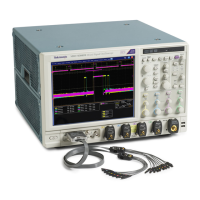Prerequisites. A math waveform must be defined and displayed.
Create a math waveform
Use the following procedure to create a math waveform. Ensure that the sources, waveforms, and measurement scalars you will
use are present. The sources do not have to be displayed.
1. From the toolbar, click the Math button to open the Math Setup control window.
2. Select the Math tab for the math waveform you want to create; then click Display Off/On to toggle it on.
TIP. If the waveform that you select already exists, its math expression appears in the window. You can still use the
waveform by clicking Clear, which discards the previous math expression. You may also want to select another waveform.
3. Click one of the Predefined Functions buttons to use a predefined math expression, or click Editor to access the Math
Equation Editor.
4. Use the Math Equation Editor control window to define a math expression. See Creating Math Waveforms for examples,
and use the following guidelines:
■
Math definitions are not implemented if the sources are not valid.
■
Use the Bksp (backspace) button to remove the last entry; click Clear to remove the entire expression and start over.
■
Use parentheses to group terms in the expression to control execution order, for example, 5(Ch1 + Ch2).
5. Select the Time, Spectral, Var, Meas, or Filter tabs to display the available functions.
6. Click a Primitive button to enter the function in the math expression. Click an operand button (+, -, *, /) to insert an operand.
7. Use the Home and arrow buttons to move within the math expression. Use the Bksp (backspace) button to delete portions
of the expression.
8. Click Apply to apply your new math expression to the math waveform.
9. Click Avgs to open the Math Averaging control window. The controls in the window apply to the math waveform defined by
the expression.
10. Click in one of the Math <1–4> n = entry boxes, and then set the number of averages using the multipurpose knobs or pop-
up keypad. This number of averages affect math waveforms if the Avg() function is used.
11. Once you have defined the math expression, click Apply in the Math Setup or Math Equation Editor windows.
Creating math waveforms
You create math waveforms when you create a math expression. You do so by applying numerical constants, math operators
and functions to operands. You can display and manipulate these derived math waveforms much like you can the channel and
reference waveforms (see Using Math Waveforms).
Some examples of typical math waveforms follow:
Math waveform operations
To normalize this waveform:
Enter this math expression: (Ch1- Meas1)/ Meas2, where Ch1 is the waveform shown at
left Meas1 = Low of Ch1 Meas2 = amplitude of Ch1
How to ?
DPO70000SX, MSO/DPO70000DX, MSO/DPO70000C, DPO7000C, and MSO/DPO5000B Series 599
